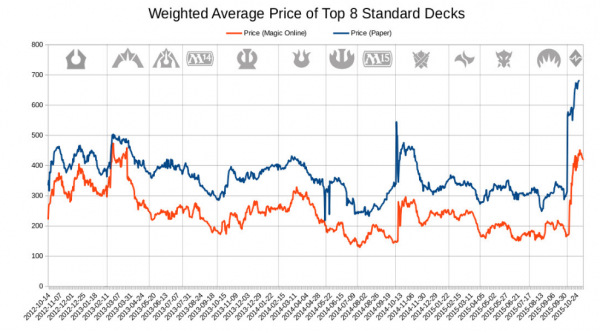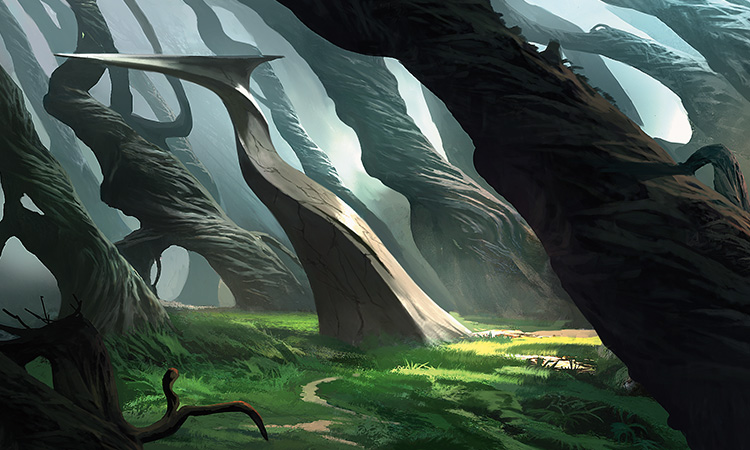Are you a Quiet Speculation member?
If not, now is a perfect time to join up! Our powerful tools, breaking-news analysis, and exclusive Discord channel will make sure you stay up to date and ahead of the curve.
Standard has been quite the format to watch as of late. Along with myself, other writers on QS have written a plethora of articles about Standard. We've been following the rapidly changing format since SOI was released, from the beginning doom-and-gloom dominance of Collected Company, past the Pro Tour, to the eve of Eldritch Moon's release.
While many will attest (and they're right) that the format is largely solved and G/W Tokens is the undisputed "deck to beat," it's still fascinating that we see so much innovation on this format. Week in and out, it seems like there's another fun and incredibly interesting deck to look at in the result pages of an SCG Open or GP.
While cards like Sylvan Advocate and Collected Company still have extraordinary dominance percentages on a weekly basis, there are still new and exciting nuances and changes to those lists. Company lists are a plenty, and we have just seen the rise of an actual effective control list in U/R Eldrazi Control.
I wanted to take the time to highlight some of these decks that I see on a weekly basis, perhaps giving you all some ideas on what to play in the coming weeks at FNM or something to augment with new cards from Eldritch Moon.
U/W Aggro, by Hugo Terra (6th place at SCG Standard Open)
Wow, I love decks like these. Hugo Terra is onto something here, and as someone who enjoys a good aggro deck I can say for sure this is a twist on a traditional aggressive archetype. Hugo felt that the best direction for blue-white was an aggressive tempo strategy.
While Rattlechains still doesn't have viable spirits to play along with, it's still an extremely efficient and effective creature. Flying and flash are still great keywords to see on a creature, and Dimensional Infiltrator falls into that category as well. This innocuous card from Oath of the Gatewatch has silently become quite the effective creature not only in Standard (as seen in Saito's U/R Fliers) but also as a fringe card in Modern.
It turns out that the core of Rattlechains and Dimensional Infiltrator is something to build a deck around. Essence Flux is a card I always felt could have a chance, and here we are showing that it doesn't always needs to be paired with a spirit creature (though that would be great), but just a good 'ol Reflector Mage for great value.
We round out the deck with copies of all-around great cards like Declaration in Stone and Gideon, Ally of Zendikar to support the creature base. Spell Shrivel has also begun to show up in more lists, enabling archetypes like the recent U/R Eldrazi Control deck to really flourish in this format.
Bant Humans, by Todd Stevens (2nd place at SCG Standard Open)
Todd Stevens is a cool person---I know him via Twitter---and the fact that he brought up Graf Mole on Twitter prompted me to see what he was playing at the event.
Turns out Bant Humans has more than solidified itself in this meta. It seems like old news but it's a great new take on a known quantity. Collected Company strategies are nothing new, but over the course of SOI Standard I think it's awesome that we continue to see variation in the archetype. It keeps the format fresh if nothing else---and provides something for me to talk about!
The strategy of playing a bunch of humans, then dropping Thalia's Lieutenant has been a viable since day one, but this list offers so much variation in the core strategy. Throwing Duskwatch Recruiter into the mix seems like a no-brainer on the surface, but keep in mind humans never really splashed into green before this. Add a little bit of spice (enter Eldrazi Displacer) and we have ourselves quite a potent brew. Much like the Brood Monitor combo of versions before this, it seems Thalia's Lieutenant can fill that roll much easier, and close out games much quicker.
There are plenty of other examples of known-quantity decks that have evolved over the last month or so:
- Mono-White Humans adopting a red splash to utilize Reckless Bushwhacker.
- Cryptolith Rite decks are still very much alive and have adopted various 4-color versions.
- Looks like Pyromancer's Goggles lists evolved into U/R Eldrazi Control, relying on heavy end Ulamog, the Ceaseless Hunger.
...and the list goes on.
But outside known quantities and new innovations on the archetypes we've all grown accustomed to by now, SOI Standard still has plenty of curve balls to throw our way. People still seem to sleeve up unorthodox decks and end up performing quite well (even if it is sporadic).
Like this next deck by Jared Greenway:
Temur Clues, by Jared Greenway (7th place at SCG Invitational Qualifier)
Never thought I would see Weirding Wood in Standard---I guess green is even better than I thought. I think this deck can be summed up as, "All the cards I want to play in Standard---but which weren't good."
Format Diversity Financial Outlook
Why am I harping on format diversity so much? Well, other than being interesting and fun, a diverse format is beneficial for players when it comes to talking prices.
A general trend shows us that overall new set prices drop considerably because today's supply is way higher then ever before. Some anomalies and high Standard prices may still happen (we saw this with the coupling of Jace, Vryn's Prodigy and Khans fetchlands), but largely now that the two-block cadence is in full swing we see lower card prices on average.
While players may be spending on new sets more often, they will likely be spending less overall on specific cards. We can see this in action already---high-dominance cards like Sylvan Advocate are only $5. Sure, you have your chase mythics like Nahiri, the Harbinger, but when you look at the trend you realize that most cards required to build an effective deck are under $10.

We can see this with SOI Standard prices in the course of just two months---a considerable 25% decrease in format price. While some cards may fluctuate in that time and certain cards trend upwards as they become popular, there will always be a card that subsequently decreases by just as much. There's just a metric ton of supply in today's market.
It's hard for most cards to maintain prices over $10, and diverse formats compound that scenario. When players can choose between four different versions of Humans, or Collected Company decks (or...Clues?), they're more likely to choose the list that costs less (and is still viable).
I did mention that Standard can still be expensive, and I'll have to make sure to track this going forward so there's more data behind the two-set block structure. But, my feeling is that this new method of releasing sets greatly alleviates format prices overall. Just from the preliminary data, we already see with an increased speed of releases players will be spending more frequently but less overall on individual cards.

Coming from the expensive Khans of Tarkir Standard with Jace, Vryn's Prodigy plus fetchlands, to today's SOI Standard, the format price has decreased dramatically. With average prices of decks roughly in the $600-700 range we see a 50% decrease (taking numbers from the MTGGoldfish Metagame Page), with deck averages in the new format trending in the $300 range.
I also went ahead and looked around for metagame snapshots of previous Standards to verify that very diverse metagames coincide with lower overall average value:
- Return to Ravnica/Theros metagame snapshot (Nick Vigabool GatheringMagic): 14 different archetypes over 1% with "Other" at 21%---looking at the chart above, the average cost of the format fluctuated between $400-500 with a low of $300.
- Theros/Khans of Tarkir metagame snapshot: 18 archetypes over 1% with "Other" at 24%---average format cost fluctuated between $300-400 with a low of $250.
- Khans of Tarkir/Battle for Zendikar metagame snapshot: 13 archetypes over 1% with "Other" at 19%---average format cost around $700.
- Average cost of SOI Standard Top 8 archetypes (taken from MTGGoldfish's Metagame Page): $297
The data isn't finalized yet in terms of a metagame breakdown for Shadows Over Innistrad Standard. But by the looks of it we're looking at one of the cheapest Standards in quite some time. I guess anything seems affordable coming from an average $700 Standard that was KTK/BFZ. SOI looks to be just as diverse as its predecessor formats and there is a correlation to diverse formats and cost. I would say that BFZ Standard was a "perfect storm" when it comes to cost. Jace, plus fetchlands, plus battle lands was just a disaster for players.
While the data is still inconclusive, I think the general trend of Standard is going in the right direction. We will need more sets to release under the two-block structure to have more detailed numbers, but I think my inclinations will be realized very shortly. Obviously Eldritch Moon will release and prices will likely be in flux again---but I think the law of averages will prevail yet again when the dust settles and the initial hype and craze has subsided.
I've talked about this with fellow writers many times on many platforms---it's just hard for cards (rares and mythics alike) to maintain a price tag over $10 and we've seen this for a little while now:
Standard staples under $10
So, go out there and enjoy some Standard. It's diverse, it's fun and it's affordable. Sure, if you want to win handily I would suggest playing a "solved" deck like G/W Tokens. At the same time, I would also suggest sleeving up something off-beat. My personal choice would be Hugo Terra's list, or Saito's U/R Fliers---there's just so much diversity in this format and I think it will only get better as we go.
As always I'd love to discuss everything I talked about. What do you think the new block cadence structure will bring? What are your thoughts on low Standard prices? Comment away!
-Chaz
@ChazVMTG





